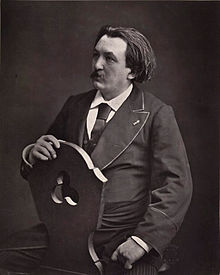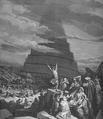Gustave Doré

Paul Gustave Doré (born January 6, 1832 in Strasbourg , † January 23, 1883 in Paris ) was a French painter and graphic artist who made a name for himself primarily as an illustrator .
biography
Doré's talent as a draftsman was already noticed when he was still a student. In addition, at the age of seven he began to play several instruments, including the violin , which he subsequently mastered with virtuosity. When he was nine years old, he first tried to illustrate Dante Alighieri's Divine Comedy . He came to Paris at the age of thirteen and worked as an illustrator for the Journal pour rire in 1847 at the age of 15 . In the same year his first work, The Adventures of Hercules , was published by the Paris publishing house Aubert.
In 1853 he got the opportunity to contribute the illustration to the works of Lord Byron . Commissions for other publications followed, including the illustration of the English Bible. Ten years later (1863) Doré took care of the illustration of the French edition of Miguel de Cervantes ' Don Quixote , for which he made 370 pictures. From then on, his work influenced artists of various genres. The oversized edition (1884) of Edgar Allan Poe's narrative poem The Raven , for which the French created over 25 steel engravings , is also known.
Due to the success of his Bible illustrations of 1866, Doré was able to hold a major retrospective in London a year later, which led to the establishment of the Doré Gallery on Covelant Bond Street. In 1869, the English journalist William Blanchard Jerrold commissioned Gustave Doré to create a comprehensive portrait of London with him. Doré signed a five-year contract with the publishing house Grant & Co. During the duration of the project, it was claimed, the illustrator had to spend three months per calendar year in the capital of the Empire, as he received the enormous sum in return every year from £ 10,000.
In 1872 the book was published with the title London: A Pilgrimage . It contains 180 engravings that were successfully sold commercially, but were also exposed to harsh criticism. Most of the critics accused Doré of having placed the focus mainly on the slums and thus on the proletariat. Despite this, the artist received numerous follow-up orders in Great Britain.
Gustave Doré died on January 23, 1883 in Paris of a heart attack. The artist was only 51 years old and left behind an impressive oeuvre with several thousand individual pieces. He found his final resting place in the Père Lachaise cemetery (Division 22).
Retrospective (selection) and influence
He became known in 1854 with his wood engravings in François Rabelais Gargantua and Pantagruel and in 1855 Honoré de Balzac's Tolldreiste stories . In the following he illustrated around 90 works of world literature, including:
| year | author | plant |
|---|---|---|
| 1861 | Dante Alighieri | Divine Comedy |
| 1862 | Gottfried August Bürger | Munchausen |
| 1862 | Charles Perrault | fairy tale |
| 1863 | Miguel de Cervantes | Don Quixote |
| 1866 | diverse / unknown | Bible |
| 1866 | Jean de la Fontaine | Fables |
| 1866 | John Milton | Paradise Lost |
| 1866 | Samuel Taylor Coleridge | The Rime of the Ancient Mariner |
| 1879 | Ludovico Ariosto | Orlando furioso |
| 1884 | Edgar Allan Poe | The Raven |
Doré's Bible illustrations are still among the most famous of all, he is considered one of the greatest masters of this genre. Doré's 230 Bible graphics were engraved by famous graphic artists Pisan, Pannemaker and Laplante, among others.
He created bizarre representations of mythical creatures, monsters, skeletons and mysterious legendary figures. The stitches are excellently crafted, the depth effect and the representation of the light are masterful. His work had a decisive influence on the surrealist Salvador Dalí , who also oriented his graphic work on the major themes of world literature. Walter Moers , who in 2001 constructed his novel Wilde Reise durch die Nacht around 21 Doré's images, was also very impressed by Doré's work . According to the artist Valentine Hugo, Max Ernst used Doré's graphics as well as contemporary illustrations for his collage series Une semaine de bonté - A Week of Goodness (1933). Dorés himself described his illustrations for Samuel Taylor Coleridge's The Rime of the Ancient Mariner as his best.
Work examples
Francesca and Paolo da Rimini , Canto V of the Divine Comedy , Inferno
Caricature of Munchausen
literature
- Friedrich Wilhelm Bautz : Gustave Doré. In: Biographisch-Bibliographisches Kirchenlexikon (BBKL). Volume 1, Bautz, Hamm 1975. 2nd, unchanged edition Hamm 1990, ISBN 3-88309-013-1 , Sp. 1360-1361.
- Gotthard Brandler (Ed.): Gustave Doré. 2nd edition Eulenspiegel-Verlag, Berlin 1990, ISBN 3-359-00253-9 (1st edition Berlin 1988 in the same publisher under the same ISBN); (Catalog of the exhibition of the same name, Monastère royal de Brou , May 12 to September 16, 2012)
- Walter Dirks: Doré's Pictures and Allioli's Bible Text Today , Hasso Ebeling Verlag, Luxembourg, 1974, ISBN 3-921195-13-6 .
- Magali Briat-Philippe u. a .: Gustave Doré. Un peintre . Somogy, Paris 2012, ISBN 978-2-7572-0551-8 .
- Konrad Farner : Gustav Doré. The industrial romantic. Dresden 1962, Rogner and Bernhard, Munich 1975.
- Nigel Gosling: Gustave Doré . David & Charles, Newton Abbot 1973.
- German translation: Gustave Doré . Rembrandt Verlag, Berlin 1975, ISBN 3-7925-0223-2 .
- Herwig Guratzsch , Gerd Unverfetern (Ed.): Gustave Doré. 1832–1883 (The bibliophile paperbacks; 2 vols.). Harenberg, Göttingen 1982, ISBN 3-88379-348-5 (catalog of the exhibition of the same name, Wilhelm Busch - German Museum for Caricature and Drawing , October 17, 1982 to January 9, 1983).
- Illustrator, painter, sculptor. Contributions to his work .
- Catalog of the exhibited works .
- Philippe Kaenel: Le métier d'illustrateur 1830–1880. Rodolphe Töpffer , Grandville , Gustave Doré . Édition Messene, Paris 1996, ISBN 2-911043-08-1 (also dissertation, University of Lausanne 1994).
- Dan Malan: Gustave Doré. Adrift on dreams of splendor; a comprehensive biography and bibliography . Self-published, St. Louis, Mon. 1995, ISBN 0-9631135-8-5 .
- Walter Moers : Wild journey through the night . Eichborn Verlag, Frankfurt / M. 2001, ISBN 3-8218-0890-X (with Doré's illustrations, a tabular biography and a list of the most important works)
- Eric Zafran (Ed.): Fantasy and faith. The art of Gustave Doré . Dahesh Museum of Art, New York 2007, ISBN 978-0-300-10737-1 .
Movie
-
Gustave Doré's world of images. (OT: Gustave Doré. De l'illustrateur à l'artiste. ) Documentary, France, 2014, 53 min., Script and direction: Pascale Bouhenic, production: Zadig Productions, Unité Arts et Spectacles, arte France, first broadcast: 23. February 2014 at arte, table of contents by arte.
Documentation on the occasion of the Doré exhibition in the Musée d'Orsay in Paris from February 11, 2014 to May 11, 2014.
Web links
- Literature by and about Gustave Doré in the catalog of the German National Library
- Works by and about Gustave Doré in the German Digital Library
- Works by Gustave Doré at Zeno.org .
- Gustave Doré at Google Arts & Culture
- Art Passions Doré Gallery
- The illustrations by Gustave Doré in Gustave Aimard's "Free Ball"
- Don Quixote. 120 illustrations PDF in the GASL's Arno Schmidt reference library (23.84 MB)
- Image collection and description - Gustav Doré on SurLaLuneFairyTales.com
| personal data | |
|---|---|
| SURNAME | Doré, Gustave |
| ALTERNATIVE NAMES | Doré, Paul Gustave (full name) |
| BRIEF DESCRIPTION | French painter and printmaker |
| DATE OF BIRTH | January 6, 1832 |
| PLACE OF BIRTH | Strasbourg |
| DATE OF DEATH | January 23, 1883 |
| Place of death | Paris |











